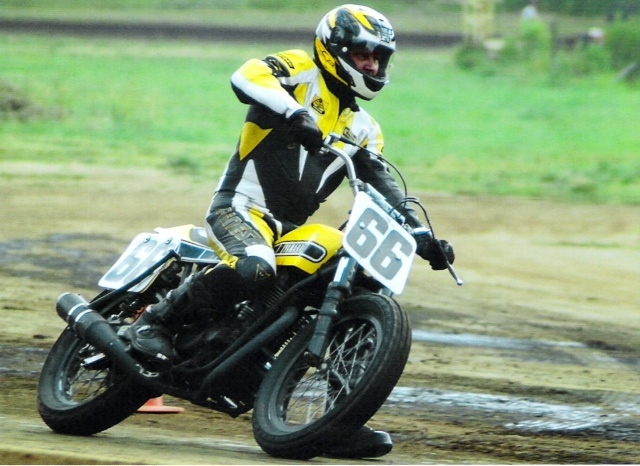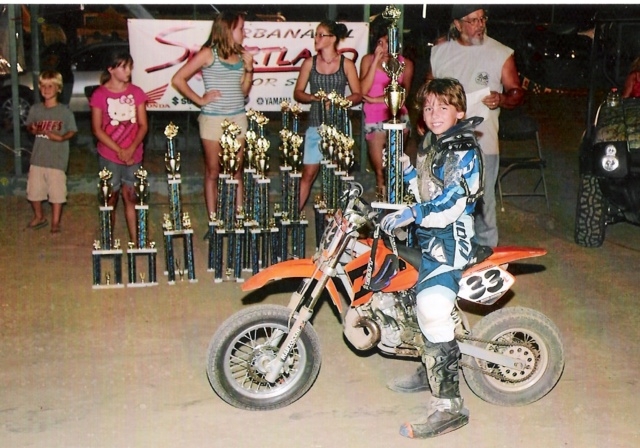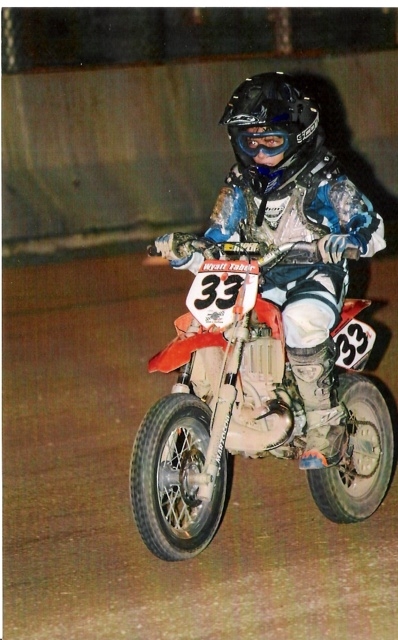 Sterling Taber has a passion for motorcycles. He works at a Harley-Davidson shop in Urbana and races whenever he can. I got to talk to Sterling about his love of bikes and how he got started in flat track racing. I admit, before this interview, I knew nothing about it. I can’t say the same now.
Sterling Taber has a passion for motorcycles. He works at a Harley-Davidson shop in Urbana and races whenever he can. I got to talk to Sterling about his love of bikes and how he got started in flat track racing. I admit, before this interview, I knew nothing about it. I can’t say the same now.
Smile Politely: Tell me about the races in Champaign-Urbana.
Sterling Taber: At a race like Champaign, there’s not a whole lot of glamour, but if you’re paying attention, you’ll see the seeds of greatness. Nicky Hayden, a world champion in road racing, started out as a little kid, racing multiple classes at Champaign, doing the fair circuit with his family. Kenny Roberts is another World Champion who was here in the ’70s. A lot of the guys who run for the number one plate, the National Series championship, will stop in to make a few bucks.
SP: What is flat track racing?
Taber: Flat track or dirt track racing is the only purely American form of motorcycle racing. More popular forms of motorcycle racing, such as motocross or road racing originated in Europe. Sometime shortly after the motorcycle was invented, someone came up with the idea of racing around the only tracks that existed: horse racing facilities or fairgrounds. Next thing you know, you have flat track!
Prior to WWI, flat track racing was extremely popular, with tens of thousands of people in attendance. More recently, flat track’s heyday was in the late 1960s and early 1970s. On Any Sunday was a motorcycle racing documentary, directed by Bruce Brown of Endless Summer fame and financed by Steve McQueen, that showcased flat track. Find it!
SP: How did you get into motorcycle racing?
Taber: I grew up going to races [as a spectator] at Indianapolis, Louisville, Peoria, and, of course, the Springfield Mile in Springfield, Illinois. I always wanted to give it a try, so, a few years ago, my son Wyatt started doing it (with some encouragement from me, I admit). I thought, ‘Why am I sitting here watching when I could be out there, too?’ So I found an older Yamaha TT500 and started participating in the Vintage class for bikes built before 1980. That was five years ago. So, at 41, I’m a latecomer to the sport.
SP: It’s never too late to start, obviously! When did your son start racing?
Taber: My son started when he was five years old in the 50cc class.

SP: Are there different categories of prizes, or does the fastest win and that’s it?
Taber: The races are broken down into various classes, depending on the rider’s age or the displacement of the motorcycle they’re riding. There [are] classes [from] 5- to 8-year-olds up to the ‘Super Senior’ class for riders over 50 years old. Notice there are no gender classes. Everyone is equal under the helmet. In fact, two riders to watch are Molly Terry from the Peoria area, who just turned pro this year, and Morgan Monroe from northern Indiana, who rides a 250cc at 14 years old. They’ve both been regular attendees at our fair.
Each class will run a heat race which determines their starting position in the main events. Trophies are awarded for riders who place in the top three. The riders in the 5- to 8-year-old class all receive a trophy.
Each race is five to eight laps in length, except for the little kids, which are only three laps. Even at 25–30 mph it takes them a while to get all the way around the 1/2 mile track.
SP: What kind of skills does a rider need to stay in the lead?
Taber: Larger bikes, which include 450cc bikes from Honda, Yamaha, Suzuki, and Kawasaki, will reach speeds of 80 mph on the straightways. It gets impressive to watch when they reach the corners, put their inside foot down to help balance, and slide sideways through the corner. A good sense of balance and an iron will help when negotiating the track. Riders will pass within inches of each other. Riders on the massive Harley-Davidson XR750s are always a crowd favorite. Some great spots to watch this from: the bed of a pickup truck in the infield; in turns three and four; or from the beer tent in turn one. Be sure to cover your drink when they come by, as you will get showered by dirt and gravel!
SP: Sounds like a lot of fun! And dangerous! Ever get into an accident or seen a really bad one?
Taber: I had a wreck a couple of years ago at the Springfield Shorttrack. A smaller track like that makes for some close racing and the occasional bump. I think my handlebars tangled with another rider and down I went. Three broken ribs, a broken scapula, bruised lung, and a night in St John’s.
Over the years I’ve seen quite a few scary wrecks. Too many to describe, actually. What surprises me is the number of wrecks that I think are severe or potentially fatal — and the rider walks away!

SP: They must have done something right…
Taber: Believe it or not, there are techniques to crashing, which can help keep you safer and increase the chance of ‘lowsiding,’ or sliding the bike down — as opposed to getting flipped off or ‘highsiding.’ As long as you’re sliding and not tumbling, you’ll probably come out of it with bumps and bruises. I tumbled, unfortunately.
A race like Champaign makes a full set of leather riding gear and a full-faced helmet a must. The track surface is ‘pea gravel’ or ‘limestone,’ not good ol’ dirt. So when you get behind someone, it’s like getting sandblasted. A newer safety innovation is a neck collar which restricts and stabilizes the neck during a crash.
SP: So there are ways to fall “safely” in motorcycle racing, just like in WWE wrestling or stage combat. Of course, there’s always a chance of injury…
Taber: If your body is positioned correctly on the motorcycle, there’s a greater likelihood of sliding out as opposed to being flipped off, which could get you hit by the motorcycle itself.
SP: Why motorcycles? Why not ships in a bottle or sky diving? What’s special about this hobby? What drew you to it?
Taber: My dad had a motorcycle, and our bonding time was comprised of traveling around doing motorcycle events, primarily motorcycle races. My mom said when I was a baby and fussy, they’d put me between them and go for a ride in the country and I’d fall asleep.
Motorcycle racers were my heroes though. They were right up there with Walter Payton and Ryne Sandberg in my world. Kenny Roberts was ‘The King,’ not Elvis.
I get chills every time I see a flat track motorcycle. No bodywork, no knobby tires, just a huge engine and two wheels and nothing else. Just a machine [whose] only job is to go fast and turn left. They’re just like good, stripped-down rock-n-roll: three chords and loud.
SP: Obviously, you love this sport! Any dream bikes? If money were no object…
Taber: As far as a race bike, the Harley-Davidson XR750 is the absolute pinnacle, but for a bike that would suit my skill level, better [go with] an early 1970s Triumph 650.








